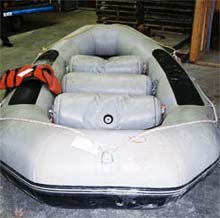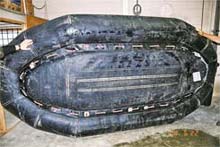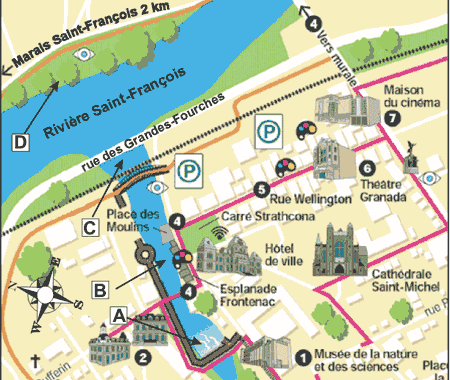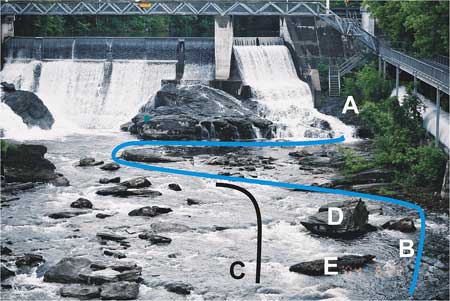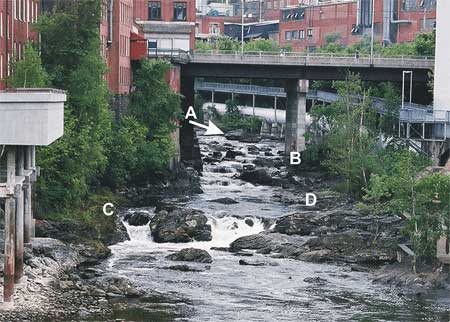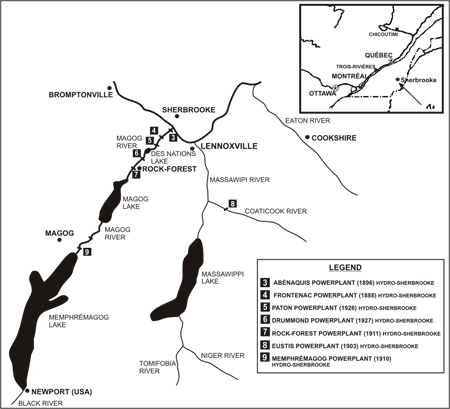Capsizing
Inflatable river raft
Magog River
Sherbrooke, Quebec
The Transportation Safety Board of Canada (TSB) investigated this occurrence for the purpose of advancing transportation safety. It is not the function of the Board to assign fault or determine civil or criminal liability. This report is not created for use in the context of legal, disciplinary or other proceedings. See Ownership and use of content. Masculine pronouns and position titles may be used to signify all genders to comply with the Canadian Transportation Accident Investigation and Safety Board Act (S.C. 1989, c. 3).
Summary
On 19 June 2004, a public activity day featuring a rafting excursion was organized on the Magog River in Sherbrooke, Quebec. The first raft left with nine passengers and a guide aboard. Less than one minute after departing, the raft struck a rock and capsized, sending all occupants into the water.
The guide and two passengers quickly climbed onto the overturned raft, which continued its descent. Two other passengers were able to cling to rocks, and a fifth passenger was recovered upstream from the last ledge. Carried by the current, three other passengers descended the river and reached the raft that, following its descent, was purposely run aground on the bank downstream from the rapids.
A ninth passenger remained stuck and submerged under a rock 5 m downstream from the point of capsizing. He was found some 1 hour and 30 minutes later and pronounced dead at the hospital.
Factual information
Particulars of the raft
| Type | Self-bailing river raft |
|---|---|
| LengthFootnote 1 | 4.2 m |
| Construction | Star Inflatables |
| Propulsion | Paddles |
| Crew | 1 guide |
| Passengers | 9 |
| Owner | Private owner |
Description of the raft
The raft is 2 m wide. It is constructed of a polyvinyl chloride (PVC)Footnote 2-based synthetic fibre. The exterior tube, which is divided into four buoyancy chambers, is angled slightly upward at both front and back. The main flotation tube and interior cross tubes are approximately 0.5 m in diameter. Transverse rigidity is accomplished by the three cross tubes fastened to the main tube with hooks and rope. The outer perimeter of the main tube has a nylon rope grab line.
The raft floor is removable and has its own air chamber. The perimeter of the raft floor has a series of grommet-reinforced holes that are used to secure it to the main tube with rope. This configuration allows any water entering the raft to drain quickly. A PVC foot brace is fastened to the floor at the back and serves as a fulcrum and brace for the guide.
The passengers sit on top of the exterior tube, with their legs inside the raft. To stabilize themselves, passengers wedge their feet into the space between the floor, the cross tubes and the main tube; there are no foot braces for the passengers. However, passengers can position themselves at the front of the raft, kneel down on the raft floor and hold on with their hands.
On 19 June 2004, nine passengers and one guide were aboard the raft. Eight passengers were seated on the main tube, four on each side, and the ninth passenger was at the front. The guide was seated on the main tube at the back.
Magog River
Flowing from Memphrémagog Lake, the Magog River is the source for the Magog and Des Nations lakes and then flows into the Saint-François River, a short distance from Sherbrooke's city centre (see Appendix A). At 30 km in length, the Magog River has seven hydroelectric powerplants. The section between the last of these dams, the Abénakis Dam, and the Saint-François River is approximately 1 km long, the first 500 m of which abounds with rapids and falls (see Figure 1).
From point A, the Abénakis Dam, to point B, the rapids extend some 500 m. Point C shows the mouth of the Magog River where the PFD and paddle were recovered. Saint-François Park, point D, was the meeting place for participants. Map from the Sherbrooke, Cité des rivières Web site at www.citedesrivieres.com, accessed 19 October 2005. (It does not exist in English.)
Rivières en fête! – Rafting on the Magog and Saint-François rivers
Sherbrooke, Cité des rivières is a corporation formed in 1999 with a mandate to start and operate a river-themed project in Sherbrooke to promote and enhance the recreation and tourism potential of the Magog and Saint-François rivers. As part of its mandate, on 19 June 2004, between 1000 and 1700, the corporation held a public activity day at Esplanade Frontenac and Place des Moulins. The activity featured a rafting excursion on the Magog River, between the Abénakis Dam and the Saint-François River. Two trips were offered: a family excursion in calm waters at the mouth of the Magog and Saint-François rivers and a whitewater excursion for adults that departed from the foot of the Abénakis Dam.
Preparation for the rafting activity
Following a call for tenders from four companies, the Sherbrooke, Cité des rivières corporation awarded the tender for the rafting excursion to an outdoor activity company that specialized in whitewater rafting. The owner of the rafting company made a first exploratory site visit in February 2004, followed by a second visit to the site on 11 June 2004.
During the second visit with a representative of Hydro-Sherbrooke, the extent to which the gate of the Abénakis Dam would be opened to produce the appropriate level of water and flow needed for the raft descent was determined. On that day, three experienced guides, accompanied by the owner, made two descents of the river without incident (see Photo 3). Furthermore, the second descent included a member of one of the corporations of the city of Sherbrooke as a passenger.
During the site assessment on 11 June 2004, the owner of the rafting company and personnel that accompanied him concluded that there was no significant risk in rafting on the Magog River because:
- the flow of the river could be controlled as needed;
- the characteristics of the river were suitable for rafting; and
- the two descents made that day were successful.
Experienced in this field, the company usually operates on a river that is much more dangerous than the Magog River. The abilities and experience on larger rivers of the guide who led the first descent were well known. Thus it was concluded that the river presented no significant risk and the possibility of capsizing was negligible. Following good practice, the crew placed emergency personnel at a strategic point on the river, ready to intervene in an emergency.
The main route from point A to point B shows the descent taken on 11 June 2004. The secondary route to point C shows the route taken on the 19 June 2004 descent. Point D is the rock struck by the raft. Point E is the rock under which the passenger was found. Photo taken on 22 June 2004.
Description of the descent
On 19 June 2004, rafting company personnel arrived early at the site. The guides started the day by walking along the river as a final assessment prior to starting the activity. Meanwhile, at Saint-François Park, the meeting point of the participants, other team members prepared the equipment.
To kick off the activity, local Sherbrooke area dignitaries and personalities were invited to make the first descent. At 0915, upon their arrival at Saint-François Park, the passengers filled out registration cards, the first section of which was for identification and health status information and the second section explained the risks involved in rafting and included a waiver to be signed by passengers stating that they assumed the risks.
Once this first step was completed, the equipment was distributed to passengers, and personnel checked to ensure that the equipment was donned and adjusted properly. A first series of instructions on the activity about to take place was given to passengers.
The first two groups to descend the river were transported by bus from Saint-François Park to the Abénakis Dam. During the bus trip, safety instructions were given to passengers. Upon arrival at the dam, some passengers helped the guides place the rafts in the water at the foot of the dam. Before going to the river, everyone was assembled for final instructions. The information provided to passengers during these three briefings addressed the following:
- the safety procedures to be followed;
- the various risks involved in rafting and the main dangers to expect during the descent;
- the position and role of the on-site emergency team in recovering persons who may have been thrown overboard;
- what each passenger could do to recover a person in the water; and
- manoeuvre techniques and paddling orders.
Before starting the activity, the Hydro-Sherbrooke official, in consultation with the owner of the rafting company, adjusted the gate, which resulted in an increase in the level and flow of water into the river downstream from the dam. Once the owner was satisfied with the river conditions, the first raft was allowed to depart.
Upon starting the descent, at approximately 1035, the guide directed the raft toward the centre of the river. The raft bypassed a first obstacle and then began to pick up speed, propelled by the river's main current. With 10 persons aboard, the raft was heavy and reacted slowly to the guide's manoeuvres. Less than 30 seconds later, the left sideFootnote 3 of the raft struck a rock. The front left side of the raft lifted out of the water, while the back right side sank. The raft quickly took on water on the right side and capsized, throwing the guide and passengers overboard.
The guide immediately climbed on top of the overturned raft. With the help of passengers who were still in the water, the guide succeeded in boarding two persons along with him and continued descending the river, carried by the current. Two passengers clung to rocks, while four others were carried by the current. One passenger was recovered before the final ledgeFootnote 4 by a member of the emergency team; the other passengers swam to the foot of the two class III+ ledges (see Appendix B).
Seeing the raft capsize, the Hydro-Sherbrooke official closed the gate to stem the flow. However, the flow upstream from the dam was not stemmed and, in 10 minutes, the water level reached the top of the dam. The river then overflowed, producing a rapid increase in the water level downstream from the dam. The two passengers who sought refuge by clinging to rocks felt endangered. The upstream passenger was recovered by a guide using a lifeline, while the other let go because of the strong current but was able to swim to the north bank upstream from the last ledge. In all, three passengers were recovered upstream from the two ledges.
Approximately three minutes after departure, at about 1038, the guide purposely grounded the raft on the south bank downstream from the last ledge, then righted it. He then recovered the three passengers who swam down the rapids. From his vantage point, he could not see the section of the river where the raft capsized or the emergency team. Without any means of communication aboard the raft, he could not relay to the emergency team the number of persons that he had recovered. He took it for granted that the emergency team would recover the missing passengers.
After waiting a few minutes, the guide placed the raft back into the water and departed for Saint-François Park with the five recovered passengers.
Upon arrival at the park at approximately 1100, some passengers went to the station for first aid and then left the site without further consideration. The guide immediately radioed a member of the emergency team to report that he had recovered five passengers. After counting the number of passengers recovered upstream of the ledges and the number provided by the guide, it was discovered that one passenger was missing. An attempt was made to locate the missing passenger on the riverbank and in the crowd. There were no clues on the river and it was thought that the missing passenger had already left the area. As a precaution, the departure of the next raft was delayed.
At approximately 1110, at Saint-François Park, a guide noticed a paddle floating at the mouth of the Magog River. While attempting to recover the paddle, a personal flotation device (PFD)Footnote 5 was spotted floating slightly upstream, with its straps still attached. The equipment was recovered and upon returning to the bank, the finding was reported by radio to the emergency team. It was at that point that it was realized that the missing person was likely in danger and that a search of the river must be undertaken. A police officer was notified of the situation and guides and police officers immediately started a search by walking along the banks. A catwalk that hangs over the river was used as an observation station.
A few times during the search, there was thought of possibly closing the dam, but no formal or direct order was given in that respect to the dam official. At 1152, the police officer who assisted the emergency team called the emergency dispatch service (911) to report the disappearance. At almost precisely the same moment, the dam official learned from a spectator that a search of the river was under way for one of the passengers. The dam official then took the steps necessary to drain the river bed. The passenger was found at approximately 1205 under a rock about 5 m from the capsizing point.
The passenger's left foot was caught under a rock, and the direction of his body pointed downstream. No helmet or PFD was found on the victim. Just after the raft capsized, the events unfolded so rapidly that the disappearance of the victim was not noticed by the guide, emergency team, raft occupants, passengers, organizers and spectators.
History of Canada's rafting industry
Commercial rafting in Canada started in British Columbia in 1972 and started in Quebec in the early 1980s. Today, rafting is also practised in the Yukon, Alberta, Ontario and Saskatchewan. According to Transport Canada, Canada has approximately 230 rafting companies that serve over 230 000 customers each year.
An outdoor activity is considered a recreational activity by Quebec's Secrétariat au loisir et au sport (Sports and Recreation Secretariat) if it is practised outdoors, is non-competitive and includes a respect for the natural environment. Although rafting is also practised competitively, the rafting activity that took place on 19 June 2004 was considered an outdoor activity. Rarely do individuals purchase the equipment they need for rafting. As such, there is a high level of demand for this type of service. In Quebec, depending on the season, about 20 outfitters share between 40 000 and 50 000 customers per year.Footnote 6
According to a study published in 2002 by the Chair of Tourism at the Université du Québec à Montréal, [Translation] "the few statistics gathered on rafting reveal that this activity's level of risk is less than we think . . . . The possibility of drowning must however be taken into consideration. . . ."
Between 1994 and 2003, offices of the coroner in the Yukon, Alberta, British Columbia, Saskatchewan and Quebec identified a total of 23 deaths in the practice of this sport. On the other hand, in May 2004, Quebec's ministère des Affaires municipales, des Sports et du Loisir (Department of Municipal Affairs, Sports and Recreation) presented an analysis of mortality data from the Office of the Chief Coroner of Quebec in which was compared the rate of mortality caused by recreational and sports-related injuries for several sports and activities practised in Quebec. More specifically, between 1990 and 2002, 5 deaths had been attributed to rafting. In other words, rafting accounted for 0.3 per cent of all deaths resulting from recreational and sports-related injuries during the above-mentioned period.
Rafting regulations
National
Following an accident that resulted in the death of three persons in British Columbia in 1979, Transport Canada introduced in 1981 the River Rafting Standards (TP 8643) and amended the Boating Restriction Regulations by introducing Schedule VI.1 – White Waters for Which a Permit is Required to Operate a Commercial River Raft. The Boating Restriction Regulations require companies wishing to operate a river raft in British Columbia to comply with the parameters of the River Rafting Standards and to hold a permit. At present, Canada has no national Act or regulation that frames the safety aspect of the practice of rafting for the rest of the country.
The River Rafting Standards were amended in 1987, following a series of accidents that resulted in the death of 12 persons in British Columbia. In their present form, the standards apply to the following parameters:
- construction;
- maximum load capacity;
- safety equipment that must be aboard;
- trip leader and guide qualifications; and
- minimum requirements for operating commercial river rafts.
At present, there are no mandatory national regulations that prescribe training and qualifications for rafting guides in Canada. The River Rafting Standards (TP 8643) address the issue, but they are not mandatory across Canada. Besides, most stakeholders consulted were not aware of this legislation.
The safety standards issued by the Canadian Rivers Council have a chapter dedicated to guide training and qualifications. Despite the virtual disappearance of the Council, Quebec outfitters continue to adhere to these standards. However, the Council no longer verifies whether these standards are adhered to or if guides are qualified.
A consultation with some companies across Canada revealed that, in general, most guides hired have basic or advanced first-aid certification and, in several cases, have had training in cardiopulmonary resuscitation. Furthermore, most of these companies also require that guides have swiftwater rescue training. Also of note is that these companies provide specific training to new guides on guiding rafts in the rivers on which they operate.
British Columbia
Following a series of fatal accidents in 1987, the British Columbia Government developed legislation to set out rafting safety guidelines and implemented the Commercial River Rafting Safety Act, and regulations for implementation. Despite repealing this Act in 2004, all outfitter members of the British Columbia River Outfitters Association have continued to self-regulate based on the spirit of the former Act.
Alberta
Alberta has no regulations governing whitewater rafting. The Jasper National Park Professional River Outfitters Association and the Professional River Outfitters Association of Alberta are two Alberta rafting outfitter associations. These associations gave themselves the mandate to promote rafting safety by applying safety standards they developed for their membership.
Ontario
Some Ontario outfitters apply the Canadian Rivers Council standards. These standards address persons taking part in whitewater rafting, the training and responsibilities of persons who deal with passengers, the organization and sequence of the event, the facilities and equipment used, and the safety services and equipment required.
Quebec
In Quebec, the Loi sur la sécurité dans les sports (Act Respecting Safety in Sports) promotes safety in the practice of physical activity engaged in at the beginner level, for recreation or for competition. Among other things, this Act requires that federations of sports bodies or unaffiliated sports bodies adopt safety regulations on site quality, participant equipment, participant health control and standards for the practice of the sport. The safety regulations for rafting accepted by the Quebec Government for rafting are the Safety Regulations of the Canadian Rivers Council (Rafting).
The legislation does not apply to all companies that offer this sport. Moreover, it cannot force a private company to become a member of a federation or sports body and thus enforce the legislation. After determining that this provision of the regulations was insufficient following an accident on the Montmorency River in 1989, a coroner recommended to the Quebec Government that it should [Translation] ". . . grant the RégieFootnote 7 . . . the power to extend the application of the safety regulations to unaffiliated sports bodies and, at the discretion of the Régie, to the sport practised."Footnote 8 This recommendation has still not been implemented by the Quebec Government.
Following two Quebec rafting accidents in 1992 and 1994, Régie inspectors visited Quebec rafting companies with a view to invite them to better supervise their activities. Suggestions made by the inspectors included becoming members of the Canadian Rivers Council and adhering to its safety standards. Without the restrictions of the Loi sur la sécurité dans les sports (Act Respecting Safety in Sports), most of the outfitters have followed the recommendation.
Canadian Rivers Council and Aventure écotourisme Québec
Founded as the Eastern Canadian River Outfitters Association in the 1980s, the Canadian Rivers Council was until most recently the only association of Quebec and Ontario rafting companies. In the past few years, however, the number of personnel of this association has been reduced significantly. In Quebec, rafting companies have come under the supervision of Aventure écotourisme Québec, a group of adventure and eco-adventure tourism operators whose mission is to represent and promote the interests of its members to develop a high-quality product. To date, Aventure écotourisme Québec has not developed its own rafting safety regulations but does require member outfitters to adhere to the Canadian Rivers Council standards.
Rafting company personnel
Personnel distribution
On 19 June 2004, nine employees accompanied the company official. For operations to run smoothly, tasks were delegated to each staff member. One employee was in charge of equipment at Saint-François Park and another looked after the bus transportation of participants. Six guides looked after the rafts and passengers; two guides were responsible for the family component of the activity, while four guides were assigned to the whitewater descent. Lastly, the emergency team was composed of a kayaker and a guide with a bag of lifelines. The emergency team focussed its efforts from a site downstream from the first large ledge (see Photo 4).
Personnel qualifications and experience
The rafting company owner had 15 years' experience in rafting, rafting-camping, sea kayaking and family rafting. He had had defibrillation training and held a pleasure craft operator card. He had also had the training necessary to be a swiftwater rescue instructor, a first-aid instructor and a remote area first-aid instructor.
The guide in charge of the raft that capsized had 5 years' experience in rafting, rafting-camping, river kayaking and sea kayaking. He held a restricted radio operator's certificate (marine) and a sea kayaking level II certificate. He had also had defibrillation training, first-aid instructor training and remote first-aid instructor training.
The other employees had more or less the same training and had between one and five years' experience in rafting.
Equipment lent to passengers
The company lent each passenger a paddle, a safety helmet and a PFD. The PFD the victim was wearing at the time of the accident was adult size "large/XX-large" that provided a buoyant force of 97 newtons (N). It could be worn by a person weighing over 41 kg and was United States Coast Guard-approved. The PFDs and safety helmets used at the time of the accident did not have the seal of approval based on the criteria set out in the River Rafting Standards (TP 8643). The equipment did provide sufficient protection to absorb head impacts and a significant buoyancy reserve, without hindering freedom of movement. It is the type of equipment that is usually used by the rafting industry in Canada and around the world.
When the raft capsized, the force of the current most definitely led the body toward and held it under a rock (see photo 3, point E). After death, the passenger's body went into a state of hypotonia, that is, low muscular tension. The constant pressure of the current on the body of the unconscious passenger resulted in the victim losing his helmet and PFD.
River morphology
The bed of the Magog River downstream from the Abénakis Dam is covered with rocks which, over the centuries, have been shaped by the water. As such, most of the predominant rocks in this section of the river have seen their bases erode faster than their tops, thereby leaving their bottoms wedge-shaped, pointing downward, like the rock where the passenger was recovered. This particular morphology is conducive to trapping a person who is pushed by the current against such a rock. Further, this section of the river was largely shaped by man over the centuries. In the past, industries harnessed the river's water power for development. Now gone, these structures have nevertheless left their mark in the form of ends of pipes, concrete structures, etc. Thus, on the bed and the banks of the gorge, there are sharp objects that, without apparently having contributed to the accident, represent hazards for the practice of water sports in this section of the river.
Description of the water wlow control and level of the Magog River
Hydro-Sherbrooke, which was municipalized in 1908, is responsible for dams and hydroelectric powerplants on the Magog River. The service can adjust the water levels on the different bodies of water it manages, for specific needs, while respecting certain required minimum and maximum levels based on local and extraterritorial agreements. During the 19 June 2004 activity, an official from water level control downstream from the Abénakis Dam was assigned to manually operate a gate at the southern extremity of the dam. To ensure that there was always a sufficient quantity of water upstream from the dam, water flow was controlled beginning at Des Nations Lake (see Appendix A) by another official of the system control centre. The two Hydro-Sherbrooke employees were in radio contact at all times during the activity.
Preparation for the descent
As is common practice, to make a rafting excursion safer and to make each individual aware of the raft's behaviour in white water, an exercise is completed before departure. Under the guide's direction, passengers learn about manoeuvring a raft as a team and, one by one, jump into the water to acclimatize to the element and to practise rescue manoeuvres.
On 19 June 2004, the passengers took part in an information session before departure; however, practising the recovery of persons overboard, team manoeuvres and paddling orders were not carried out before departure. Also, the descent that the guide made was his first on the Magog River; he did not take part in the 11 June 2004 descents. Further, with the exception of one passenger, this was the first whitewater experience for all the other passengers.
Findings
Findings as to causes and contributing factors
- When assessing the Magog River, it was concluded that there was no great danger and that the risk of capsizing was negligible.
- Despite holding an information session before departure, practising the recovery of persons overboard, team manoeuvres and paddling orders were not carried out before departure.
- The raft reacted slowly to manoeuvres performed by the crew and capsized after striking a rock; the guide and all passengers were thrown into the water.
- Because of a lack of communication between the guide and the emergency team, approximately 25 minutes elapsed before anyone realized that one of the passengers was missing.
- The guide had never made a descent in this section of the Magog River.
Findings as to risk
- Canada has no mandatory national regulations that prescribe training and qualification requirements for rafting guides. The River Rafting Standards (TP 8643) do address the subject, but are not mandatory across Canada.
- Quebec's Loi sur la sécurité dans les sports (Act Respecting Safety in Sports) does not apply directly to the sport practised and cannot force a private company to become a member of a federation or a sports body and thus apply the Act.
Other findings
- No official and direct order was given to the dam official to close the dam.
- The particular morphology of the rocks in the Magog River is conducive to trapping a person that is pushed toward them by the current. On the river bed and banks, there are sharp objects that, without apparently having contributed to this accident, represent hazards for the practice of water sports in this section of the river.
- There is no device to quickly locate a person in difficulty under water. The passenger remained caught under a rock approximately 5 m from the capsizing point and nobody could see him.
Safety action
Action taken
Since the fall of 2003, and unrelated to the Magog River accident of 19 June 2004, Transport Canada has made the proposed Special Purpose Vessels Regulations publicly available. The proposed regulations apply to inflatable boats that carry persons on an excursion for remuneration. The River Rafting Guide Training and Examination Standard (TP 14223) will complement the regulations and will be published in the Canada Gazette, Part I, in early 2006. These initiatives will replace the River Rafting Standards (TP 8643).
This report concludes the Transportation Safety Board's investigation into this occurrence. Consequently, the Board authorized the release of this report on .
Appendices
Appendix A - The Magog River and its hydroelectric dams
Appendix B - International scale of river difficulty
Note: There are slight variations in the international scale of river difficulty in use in various jurisdictions.
Flat water
| I | Easy. Waves small; passages clear; no serious obstacles. |
|---|---|
| II | Medium. Rapids of moderate difficulty with passages clear. Requires experience plus fair outfit and boat. |
| III | Difficult. Waves numerous, high, irregular; rocks; eddies; rapids with passages clear though narrow, requiring expertise in manoeuvring; scouting usually needed. Requires good operator and boat. |
| IV | Very difficult. Long rapids; waves high, irregular; dangerous rocks; boiling eddies; best passages difficult to scout; scouting mandatory first time; powerful and precise manoeuvring required. Demands expert boatman and excellent boat and good quality equipment. |
| V | Extremely difficult. Exceedingly difficult, long and violent rapids, following each other almost without interruption; riverbed extremely obstructed; big drops; violent current; very steep gradient; close study essential but often difficult. Requires best person, boat, and outfit suited to the situation. All possible precautions must be taken. |
| VI (or U) | Unrunnable. |
Appendix C – Glossary
- IMO
- International Maritime Organization
- kg
- kilogram
- km
- kilometre
- m
- metre
- N
- newton
- PFD
- personal flotation device
- PVC
- polyvinyl chloride
- TP
- Transport Publication
- TSB
- Transportation Safety Board of Canada
